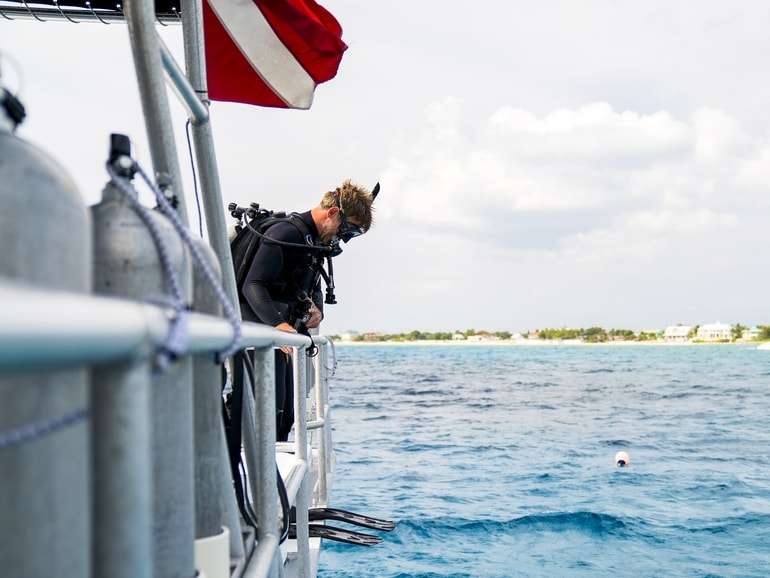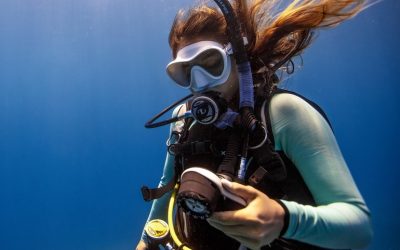Not all of us get the chance to go diving very often. In fact, most divers would fit into the category known as “holiday divers”. And while we all wish we could have unlimited time and money to be able to enjoy diving holidays whenever we want, most of us are instead bound by the constraints of the real world. If you are only able to dive once or twice a year (or even less than that), you may feel some anxiety getting back into the water after those long periods away from diving.
In an effort to help, this article will outline some key points to consider in order to keep your dive training fresh and keep yourself safe after an absence from diving. As any diver can attest to the large number of acronyms divers must learn (BCD, SPG, LPI, CESA, etc.), it is perhaps only appropriate to use another acronym here:
- B – Buddy Check
- R – Refresh Your Skills
- E – Ease In
- A – Assess Your Knowledge
- T – Tell the Dive Operator & Guide
- H – Health Check
- E – Equipment Check
So, if you haven’t been diving for a while, just remember to B-R-E-A-T-H-E (pardon the corny pun).
Buddy Check
I find it appropriate to put this point first, as it is such a simple and effective procedure yet so often ignored or done incorrectly. A pre-dive buddy check (read: before getting in the water) is an essential safety measure. Although that’s true for all divers, one could argue it is even more important for anyone who has not been diving for a while. The point of a buddy check is to catch any equipment issues before they will potentially cause a problem under the water. Clearly, if you haven’t strapped on dive gear in a while, you should be extra careful to ensure that everything is in its right place and functioning correctly.
We can recall the steps of the buddy check with yet another acronym. Most people use B-W-R-A-F, which stands for BCD, Weights, Releases, Air, Final Check. As this is not so intuitive, you may have even learned a nifty phrase to help recall it, such as Bruce Willis Ruins All Films (you can substitute “Rules” instead of “Ruins” if you are a Bruce fan), or Brazilian Women Really Are Fantastic (you can substitute “British” instead of “Brazilian” if your wife is English). Or, just go ahead and ask your Divemaster to guide you through it, if your head is too overloaded with diving acronyms to commit them all to memory.
Here is a brief description of each step of the buddy check:
- BCD – Make sure the inflate, deflate, and oral inflate functions all work properly. Keep your BCD filled at least halfway before jumping for the dive.
- Weights – Make sure you have your weight belt on, or integrated weights set up. If wearing a weight belt, check that it is right hand release.
- Releases – Check all the releases (clips and straps) on your BCD. Typical releases include the shoulder straps, cummerbund Velcro and/or clip, chest strap, tank strap, and safety strap over the tank valve. Note that the final two are on the diver’s back, so have your buddy turn around and check well that the tank strap is on tight and safety strap is in place.
- Air – Make sure each diver can breathe from both the primary and alternate air source (second stage). Also make sure the tank valve is opened all the way, and double check that the SPG needle does not jump up and down with each breath, which would likely indicate a partially opened tank valve as opposed to fully opened.
- Final Check – Make sure you have your mask and fins, and that your regulator hoses are properly streamlined. The alternate air source should be secured and easily accessible, as should the SPG.
Refresh Your Skills
Known alternately as Scuba Tune-Up or ReActivate, completing a type of refresher program is one of the best things you can do if you are feeling like your dive skills might be rusty. PADI recommends that any newer diver who has been out of the water for more than six months do a refresher before diving. A refresher typically consists of theory review, in which the diver will complete a short quiz and receive an explanation about any topic that is unclear. Then, the diver will practice some basic dive skills like regulator recovery, mask clearing, buoyancy exercises, and out of air exercises. You could do the skills session either in a pool, or in a shallow part of the open water dive site before starting the deeper part of the dive.
It is worth mentioning here that the most important skill in diving is maintaining good buoyancy control underwater. If you are worried your buoyancy might be a bit rusty, we would highly recommend you read our article Tips for Better Buoyancy Control to refamiliarize yourself with the basics of buoyancy theory and learn techniques to improve.
Ease In
Just as a runner would not run a marathon after a long absence from training, a diver should not push the limits after a long absence from diving. Ideally, for your first dive back, seek out a dive site with nice conditions, minimal currents, decent visibility, and not too deep. Once you have regained your comfort in an easier setting, then you can potentially consider more challenging dives, obviously given that they fall within the limits of your training and experience.
Assess Your Knowledge
If you have been out of the water for a while, then you will most likely be rusty on at least some of the different aspects of dive theory. Do you remember proper descent and ascent procedures, the different ways pressure affects us underwater, buddy separation procedure, out of air procedures in different circumstances, decompression theory and no stop limits, surface interval time before flying, etc.? To test your knowledge, take a look at this Quick Review (the answer key is included).
Tell the Dive Operator & Guide
Make sure the dive shop and your dive guide know that you have not been diving recently. That way, they can plan accordingly with regard to dive groups and site selection. Also, your dive guide should take extra care to give a thorough pre-dive briefing, with adequate reminders about hand signals, air checks, separation procedure, safety stop, etc.
Health
You can probably recall filling out a medical form before any dive training you’ve ever done, with a bunch of yes/no questions about various medical conditions. It is possible that some of your answers may have changed in the time since you last went diving, and it is a good idea to double check that. So, take a look at the medical form and make sure you can answer “No” to everything. If you do have any “Yes” answers, it doesn’t mean you are automatically prohibited from diving. However, you must see a doctor to get written permission to dive, if you do not already have a signed doctor’s note addressing that specific issue.
Equipment Check
If you will be using any of your own dive equipment that hasn’t been used in a while, it would be a good idea to get it serviced and tested beforehand. In general, regulators must be serviced annually. During a regulator servicing, all of the internal parts and hoses should be checked and cleaned, all the o-rings should be swapped out for new ones, intermediate pressure should be checked, and the regulator’s proper functioning should be ensured when pressurized. It is also important to check the BCD, namely that it can inflate mechanically and manually, deflate using the hose and all dump valves, and does not leak any air. Also, as annoying as it may be, you might want to try on your wetsuit to make sure you haven’t outgrown it.
Let me make a special mention of one of the simplest pieces of equipment, yet one of the most important to ensure your comfort during any dive – the mask. If you don’t have your own mask and plan to use a rental from the dive operator, make sure someone properly fits you for it. The last thing you want when getting back into diving is a mask leaking water into your eyes because it doesn’t fit. There is no such thing as a one-size-fits-all mask, so take the time to make sure you have the right mask for you.
If you recently bought your own mask, you will want to make sure you properly treat it prior to your first dive to prevent fogging. Note that I’m not talking about the normal pre-dive spit or mask defog solution. Rather, I mean that all new masks have a thin layer of silicone inside the tempered glass that must be removed to prevent the mask from fogging up easily. Hopefully if you bought your mask from a dive shop, they advised you already about some solutions. For example, you can spread toothpaste over the inner mask lens and leave it overnight. Or, some people prefer the quick and dirty method of using a lighter to burn away that silicone layer. Ideally, test the mask yourself in a pool sometime before your dive trip to ensure that it is not leaking or fogging.
Final Thoughts
As great as it would be to always keep our diving skills and knowledge fresh in our minds, we are all bound to get rusty due to lack of practice. You do not need to reread your entire Open Water manual before going diving again, but you will want to keep in mind some key points to stay safe. A little anxiety is also normal when you are diving for the first time in a while. Just remember to B-R-E-A-T-H-E and enjoy your reentry into the underwater world.




0 Comments